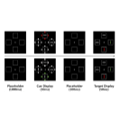Abstract
The contingent capture account of involuntary attention claims that it is guided by top-down factors, such as volitional goals or task instructions. The contrasting rapid disengagement account holds that the contingent capture account relies on the spatial precueing paradigm, which is vulnerable to the elimination of the cue-validity effect through rapid attentional disengagement. In the present study, five experiments were conducted to examine whether a spatial cue presented in a target-defining or distractor- defining color that predicted the location of a subsequently presented target at the chance level involuntarily captures attention by measuring the cue-validity effect. Additionally, to examine the influence of cue–target compatibility as an alternative indicator of attentional capture, an object identical to or different from the target object was presented at the cued location in the cue display in all experiments. The results showed that the cue-validity effect and the cue–target compatibility effect were present only when the target-color cue was presented. The object of the target display presented at the location cued by the target color was recognized even on invalid trials. By contrast, the distractor color cue did not show any indication of attentional capture or postattentive inhibition.These results imply that preattentive selection and postattentive inhibition depend on top-down attentional control setting. Furthermore, the absence of a cue-validity effect with a distractor feature is not due to the inhibition of the cued locaiton after attentional disengagement.
